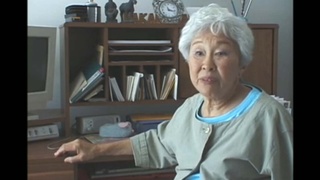Interviews
525 Quartermaster Corps
They formed what they called the 525 Quartermaster Corp and I guess they had a lot of other problem...troublemakers you might say from the Americans of German descents, Italian descents and people like us of the Japanese. So they put us into this unit called 525 Quartermaster Corp which…just to put us together and function was, just like I say, digging a whole and filling it up [laughs], a do nothing outfit. And then later on, I believe, they found out that we were good soldiers so…whenever they asked us an opinion we’ll give it but…we were obedient, we worked hard.
So, then they formed us 1800 General Service…Engineer General Service Battalion. And it was a legitimate engineering outfit. We had all the heavy equipment, build our own camps, do major bridge building and all that, so we had all those facilities. But all of us in there were ineligible for – we were all busted to privates when we got in there, and…but we were all given responsible positions, people were driving the tractors the…all the heavy equipment – as privates. And myself, I was on a pick and shovel for a while then they put me as acting supply sergeant and acting motor pool sergeant and then they put me as a company clerk, acting company clerk. So there I’m able to interact with all the officers daily, on a daily basis. They were very sympathetic to us and they knew our plight.
Date: March 25, 2005
Location: California, US
Interviewer: Sojin Kim
Contributed by: Watase Media Arts Center, Japanese American National Museum
Explore More Videos

Her experience as a Japanese-American schoolchild in Oceanside, California, after the bombing of Pearl Harbor
(1924-2018) Artist and playwright.

Finding his relative among Japanese prisoners
(b.1913) Kibei from California who served in the MIS with Merrill’s Marauders during WWII.

Teaching at the military language school during World War II
(b. 1924) Political scientist, educator, and administrator from Hawai`i

Making the decision to resist the draft
(b. 1923) Nisei from Washington. Resisted draft during WWII.

Discharged from the U.S. Army after Pearl Harbor
(b. 1918) Founder Azumano Travel

Closing the Japanese school and deportation (Spanish)
(b. 1932-2016) Peruvian painter

Death of sister in October 1942
(1915 - 2011) Nisei florist who resettled in New York City after WW II. Active in Japanese American civil rights movement

Living conditions in prison while serving time for resisting the draft
(b. 1925) Draft resister

Talking to children about decision to resist the draft during World War II
(b. 1925) Draft resister

Reflecting on Japanese Americans' response to incarceration
(b. 1925) Draft resister

Encountering a train full of Japanese Americans being transported to a concentration camp
(b. 1923) Chick sexer


Sneaking out of the Hastings Park camp during World War II
(b. 1928) Doctor. Former Chair of the Japanese Canadian Redress Foundation.

Government's permission to publish Japanese newspaper in Canada during World War II
(b. 1928) Doctor. Former Chair of the Japanese Canadian Redress Foundation.

Government urged Japanese Canadians to go to Japan
(b. 1928) Doctor. Former Chair of the Japanese Canadian Redress Foundation.
